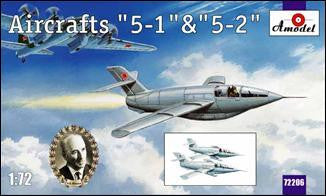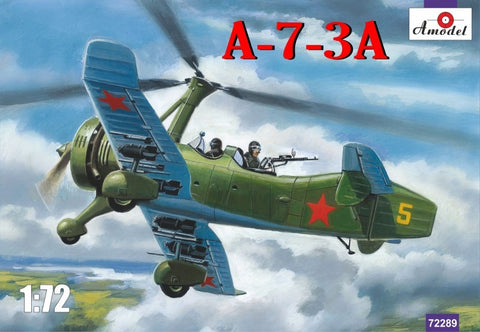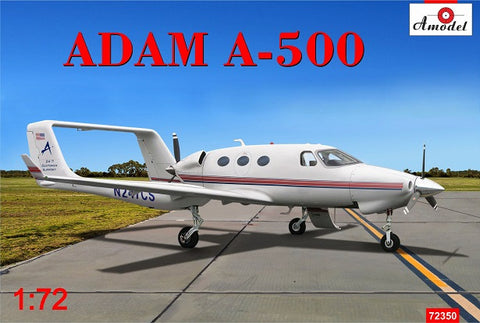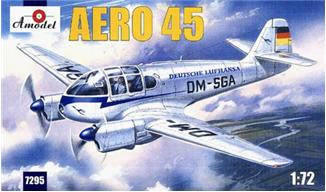
Unimodel Military 1/72 ZSU37 Russian Tank w/Self-Propelled Gun Mod. 1943 Kit
This Product Usually Ships In 2-3 Business Days
UNM-305The anti-aircraft self-propelled plant ZSU-37 was created in 1943. On chassis of SU-76...The anti-aircraft self-propelled plant ZSU-37 was created in 1943. On chassis of SU-76 there was placed an above-opened tower welded from vertical armored sheets. In the tower was placed an automatic anti-aircraft 37mm gun 61-K. An armored hull preserved the crew and units against fire of the enemy. It was the first anti-aircraft plant on a trucked chassis.Soviet engineers carried out some early experiments with tracked SPAAGs before and during World War II, including a modification of the T-70 light tank, resulting in the experimental T-90 SPAAG which was armed with two 12.7 mmDShKT heavy machine guns (the prototype was built in November 1942 byGAZ). The T-70 light tank would eventually be further developed into the SU-76 light self-propelled gun chassis, which in turn was to become the base for the ZSU-37 SPAAG.
The ZSU-37 was produced from March 1945 to 1948, and 75 vehicles were built in total (only a few vehicles were produced before the war ended, due to temporary manufacturing technology). As a result of its late production and the almost non-appearance of the few remaining Luftwaffe aircraft in the spring of 1945, the ZSU-37 saw no service in World War II. An experimental self-propelled anti-aircraft artillery battalion equipped with 12 ZSU-37 SPAAGs was formed by the end of 1945.An effort was made to significantly increase the firepower by mounting the same 37 mm gun into a quad-mount on a T-34 medium tank chassis, but the vehicle never left the design stage as it was recommended by the Technical Council of the Ministry of Transport to use a newer tank chassis and the more powerful S-68 57 mm twin anti-aircraft auto cannon, which was being developed at the time. The next step in Soviet tracked SPAAG technology would come with the ZSU-57-2, which was based on the T-54 medium tank chassis and was mass-produced in 1957-1960.The ZSU-37-2 Yenisei is a later, unrelated design based on the chassis of the experimental SU-100P self-propelled gun. It was armed with a twin-37 mm 500P Angara anti-aircraft auto cannon. The development of completely new radar-guided SPAAG vehicles, namely the ZSU-37-2 and the ZSU-23-4 began in 1957. The promising ZSU-37-2 Yenisei competed with the ZSU-23-4 Shilka as the replacement for the ZSU-57-2 SPAAG but the planned series production of the Yenisei was rejected in 1962 in favour of the production of the Shilka.The ZSU-37 was based on the SU-76M because it also shared its technical drawbacks and advantages, the most discussed of which was the open-top turret. To protect the crew from rain and snow the gun compartment could be covered with tarpaulin, however the gun could not be fully elevated when this was done. The open turret had advantages, such as high elevation angle, excellent visibility for the gunners and no need for ventilation. Light and manoeuvrable, the ZSU-37 was considered quite an effective SPAAG in the mid-1940s. However, it had insufficient off-road capabilities to accompany medium and heavy tanks in difficult terrain.
Ammunition consisted of 320 armor-piercing, fragmentation incendiary and fragmentation rounds (all with tracers). 130 rounds were in 5-round cartridges and 190 rounds were without cartridges. Armour-piercing composite rounds could be used against enemy heavy tanks. Muzzle velocity was between 890 and 920 m/s depending on projectile type, the armor-piercing shell weighed 0.785 kg, fragmentation shells weighed 0.732 kg. The auto cannon could be depressed and elevated manually between -5° and +85°. Cyclic rate of fire was 120 to 130 rounds per minute while the practical rate of fire was about 50 to 60 rounds per minute. Maximum combat vertical fire was 2,500 m while the maximum vertical range was 6,500 m.
The ZSU-37 was produced from March 1945 to 1948, and 75 vehicles were built in total (only a few vehicles were produced before the war ended, due to temporary manufacturing technology). As a result of its late production and the almost non-appearance of the few remaining Luftwaffe aircraft in the spring of 1945, the ZSU-37 saw no service in World War II. An experimental self-propelled anti-aircraft artillery battalion equipped with 12 ZSU-37 SPAAGs was formed by the end of 1945.An effort was made to significantly increase the firepower by mounting the same 37 mm gun into a quad-mount on a T-34 medium tank chassis, but the vehicle never left the design stage as it was recommended by the Technical Council of the Ministry of Transport to use a newer tank chassis and the more powerful S-68 57 mm twin anti-aircraft auto cannon, which was being developed at the time. The next step in Soviet tracked SPAAG technology would come with the ZSU-57-2, which was based on the T-54 medium tank chassis and was mass-produced in 1957-1960.The ZSU-37-2 Yenisei is a later, unrelated design based on the chassis of the experimental SU-100P self-propelled gun. It was armed with a twin-37 mm 500P Angara anti-aircraft auto cannon. The development of completely new radar-guided SPAAG vehicles, namely the ZSU-37-2 and the ZSU-23-4 began in 1957. The promising ZSU-37-2 Yenisei competed with the ZSU-23-4 Shilka as the replacement for the ZSU-57-2 SPAAG but the planned series production of the Yenisei was rejected in 1962 in favour of the production of the Shilka.The ZSU-37 was based on the SU-76M because it also shared its technical drawbacks and advantages, the most discussed of which was the open-top turret. To protect the crew from rain and snow the gun compartment could be covered with tarpaulin, however the gun could not be fully elevated when this was done. The open turret had advantages, such as high elevation angle, excellent visibility for the gunners and no need for ventilation. Light and manoeuvrable, the ZSU-37 was considered quite an effective SPAAG in the mid-1940s. However, it had insufficient off-road capabilities to accompany medium and heavy tanks in difficult terrain.
Ammunition consisted of 320 armor-piercing, fragmentation incendiary and fragmentation rounds (all with tracers). 130 rounds were in 5-round cartridges and 190 rounds were without cartridges. Armour-piercing composite rounds could be used against enemy heavy tanks. Muzzle velocity was between 890 and 920 m/s depending on projectile type, the armor-piercing shell weighed 0.785 kg, fragmentation shells weighed 0.732 kg. The auto cannon could be depressed and elevated manually between -5° and +85°. Cyclic rate of fire was 120 to 130 rounds per minute while the practical rate of fire was about 50 to 60 rounds per minute. Maximum combat vertical fire was 2,500 m while the maximum vertical range was 6,500 m.
- 120 Parks
- Detailed exterior, chassis, photo-etched parts, and link-&-length tracks.
- Includes markings for 1 vehicle.




